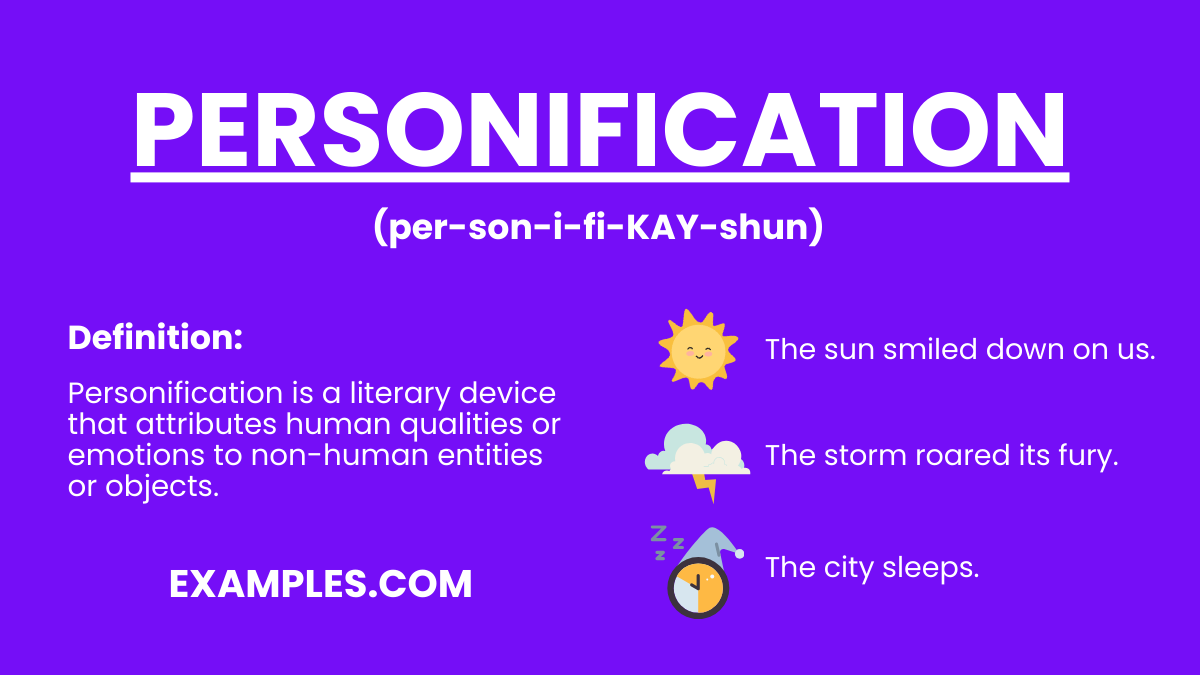Personification
Personification is a great way to make writing in English more interesting. It gives human qualities to things that don’t usually have them. This technique is part of figurative language, which helps readers feel a connection with ordinary objects or ideas. For anyone writing in English, whether you’re experienced or just starting, this guide is full of examples of personification. It also gives helpful advice on how to use this tool to make your writing really special.
What is Personification ? – Definition
(per-son-i-fi-KAY-shun)
Personification is a literary device where human qualities are given to animals, objects, or ideas, similar to a metaphor but distinct in its attribution of human characteristics to non-human entities. It involves attributing human emotions, behaviors, or actions to these entities, often creating a vivid onomatopoeia in the process. For example, saying “the wind whispered through the trees” not only personifies the wind by suggesting it can whisper, a human action, but also uses onomatopoeia to imitate the sound of whispering, enhancing the sensory experience of the description. This technique is used to make the narrative more engaging and helps readers relate to the non-human elements by giving them qualities they can understand and empathize with.
What is the Best Example of a Personification?
While the “best” example can be subjective and dependent on the context, a classic and widely recognized example is: “The wind whispered through the trees.” In this sentence, the wind, an inanimate force, is given the human action of “whispering,” painting a vivid picture of a gentle and soft breeze.
Personification Examples in Everyday Life
- “The morning sun winked at us.”
The sun is depicted as playfully acknowledging our presence, infusing the morning with warmth and promise. - “The trees bowed gently.”
Trees moving in the wind are likened to respectful gestures, suggesting a harmonious interaction with nature. - “The moon guarded the night.”
By portraying the moon as a guardian, it emphasizes its constant and protective presence during the night. - “My alarm clock leaped to life.”
This suggests the alarm clock is eager and animated, energetically starting the day. - “The wind played a symphony.”
The movement and sound of the wind are likened to a musical performance, highlighting its natural, soothing qualities. - “Stars gathered to gossip.”
This personifies stars as social beings, making the night sky seem alive with whispered stories. - “The bridge groaned underfoot.”
The sound made by the bridge is likened to a human groan, implying age and wear through the passage of many over it. - “Ocean waves kissed the shore.”
The gentle touch of waves on the shore is compared to an affectionate gesture, emphasizing the sea’s tender qualities. - “The fire danced joyfully.”
Flames moving flickeringly are likened to dancing, conveying warmth and liveliness. - “Hours marched by.”
Time is depicted as soldiers in a procession, suggesting its relentless and structured nature.
100 Famous Personification Sentence Examples

Personification breathes life into inanimate objects, animals, or abstract notions by imbuing them with human qualities. These sentences have the power to evoke deep emotions, making scenes palpable and experiences relatable. Delve into a curated list of famous personification sentences that have left an indelible mark on readers’ minds.
- The stars danced playfully in the moonlit sky.
- The sun greeted me this morning.
- The ocean waves kissed the sandy shore.
- The old tree moaned in the gusty wind.
- Time flies when you’re having fun.
- Opportunity knocked on his door.
- The flowers waltzed in the gentle breeze.
- The fire swallowed the entire forest.
- The snowflakes whispered to the ground.
- The thunder roared with fury.
- The shadows of the trees danced with the wind.
- The moon played hide and seek with the clouds.
- The cake called out to me from the refrigerator.
- The vines snaked their way up the wall.
- The mountains stood tall and proud.
- The angry clouds marched across the sky.
- The wind sang her mournful song through the falling leaves.
- The river’s water beckoned invitingly.
- The rain tapped on my windowpane, asking for entrance.
- The car complained when the key was forcefully turned.
- The daffodils nodded their yellow heads.
- The palm trees swayed to the rhythm of the island tunes.
- The sunflowers turned their faces to the sun’s embrace.
- The mailbox waved a hello with its flag.
- The hurricane’s eyes were watching our every move.
- The wind howled in the night.
- The moon guided me through the night.
- The echo of the forest called out mysteriously.
- The chocolate bar was calling my name.
- The tulips bowed their heads to the morning sun.
- The radio’s song brought tears to her eyes.
- The ruins told a story of age-old battles.
- The melon quenched my summer thirst.
- The autumn leaves were a blanket on the ground.
- The willow whispered her secrets to the wind.
- The camera loved her every angle.
- The pot called the kettle black.
- The fireworks screamed through the night sky.
- The house stared at me with looming eyes.
- The world does not wait for anyone.
- The light of the stars stabbed the night.
- The morning sun stretched its golden arms across the land.
- The fog wrapped the city in a tight embrace.
- The old guitar sang a lullaby to the audience.
- The first rays of the morning tiptoed through the meadow.
- The avalanche devoured everything in its path.
- The candle flame danced in the dark room.
- The thunder grumbled like an old man.
- The night sky draped itself over the city.
- The blizzard swallowed the town overnight.
- The train whistle screamed in the dead of night.
- The laptop hummed to life after being pressed.
- The ice cream was a temptation too hard to resist.
- The water gushed from the fountain.
- The weary heart rests in the silence of night.
- The rain played a soft melody on the roof.
- The flames of the campfire reached for the stars.
- The chocolate fondue was a dream come true.
- The stars blinked in the inky night.
- The ocean’s heart beats upon the shore.
- The streetlights bowed to the car’s headlights.
- The plot of the novel thickened with suspense.
- The flowers reached for the morning light.
- The sun peeped out from behind the clouds.
- The walls have ears.
- The pages of the diary held secrets.
- The coffee is strong enough to wake the dead.
- The clouds blanketed the city, blocking out the sun.
- The storm’s anger unleashed havoc on the town.
- The cactus stood with its armed defense.
- The church bell sang its evening hymn.
- The forest of the night was full of mystery.
- The honeybee whispered to the blooming flowers.
- The ice cubes clinked together, singing their tune.
- The bread begged to be buttered.
- The cathedral of trees was nature’s sanctuary.
- The winter’s fury crippled the city.
- The pastries winked at me from the display.
- The wind’s song was filled with sorrow.
- The ocean roared with all its might.
- The memories jumped out from the photographs.
- The universe conspired in her favor.
- The bubbles laughed as they soared into the sky.
- The bouquet of roses was an explosion of color.
- The whispering willows were nature’s storytellers.
- The night wore her starry cloak.
- The voice of the sea speaks to the soul.
- The setting sun set the clouds on fire.
- The aroma of the stew teased my senses.
- The boulevard of dreams was paved with gold.
- The frost painted the pines in white.
- The cliffs stood as sentinels watching over the bay.
- The curtains danced to the rhythm of the breeze.
- The streets whispered tales of yesteryears.
- The ice sang under the weight of the skaters.
- The books in the library held worlds within them.
- The old clock groaned as it struck midnight.
- The first blooms of spring were nature’s gift.
- The city never sleeps; it’s always alive.
- The tree limbs swayed like dancers in the wind.
Personification Examples for Kids
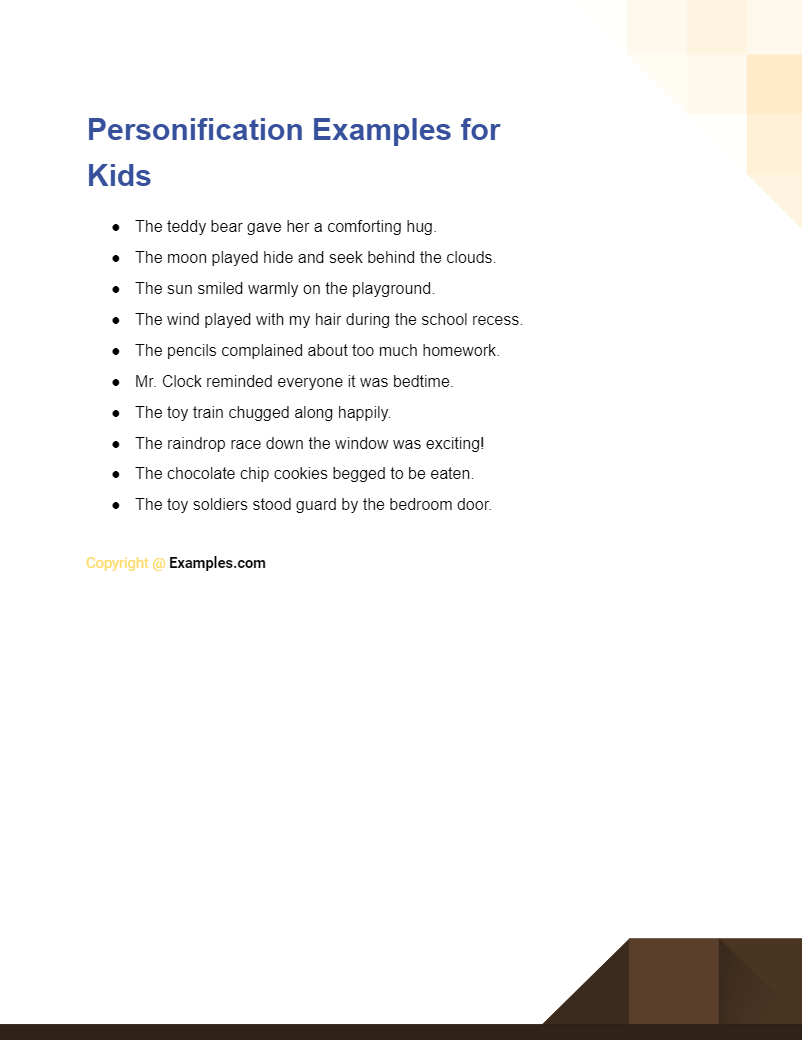
Personification examples for kids transform the mundane into magical tales. By assigning human features to objects or animals, children’s imaginations soar. Dive into these delightful examples tailored for young minds.
- The teddy bear gave her a comforting hug.
- The moon played hide and seek behind the clouds.
- The sun smiled warmly on the playground.
- The wind played with my hair during the school recess.
- The pencils complained about too much homework.
Personification Examples for Adults
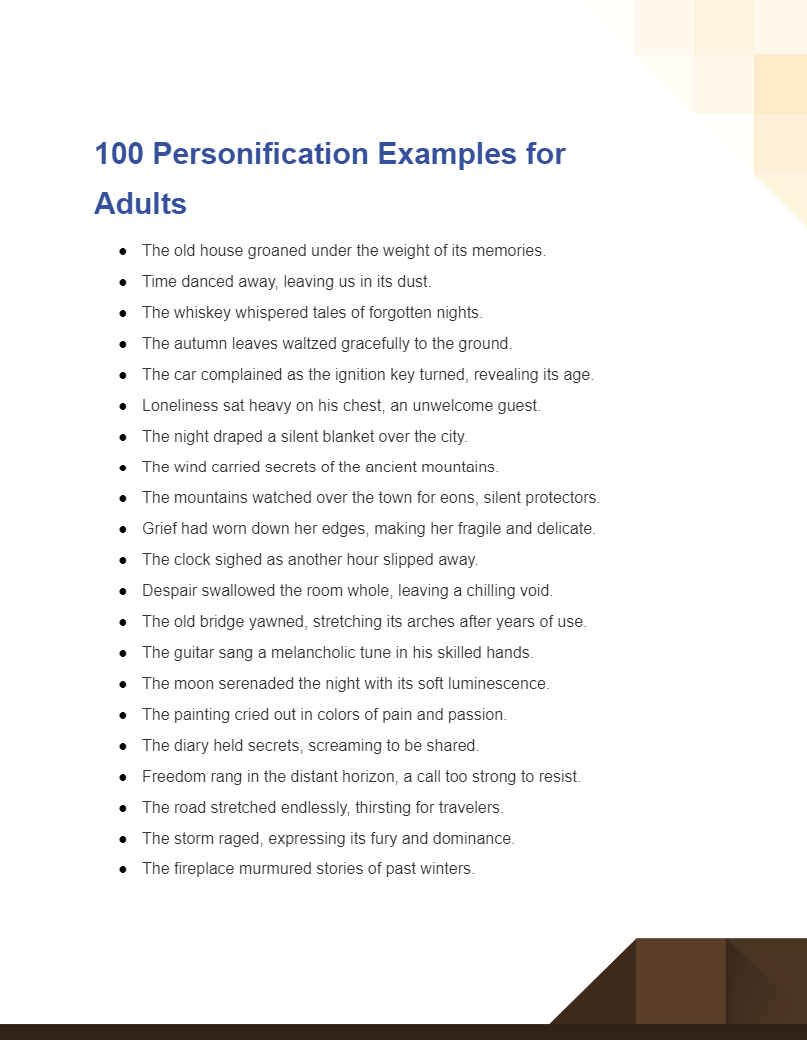
Personification examples for adults delve deeper, adding layers of emotion, insight, and depth to everyday occurrences. These instances resonate with mature understanding, subtly elevating perceptions.
- The solitude of the room wrapped around her like a shawl.
- The car grumbled about the long journey ahead.
- The aged wine whispered secrets of years gone by.
- The streets of the city echoed the tales of countless souls.
- The evening draped a veil of melancholy over him.
How to Use Personification in a Sentence
- Choose the Right Object or Concept: Select non-human elements like nature, objects, or abstract ideas for personification.
- Attribute Human Qualities: Give these elements human characteristics, emotions, or actions.
- Enhance Descriptive Imagery: Use personification to create vivid and imaginative descriptions in your writing.
- Maintain Relevance: Ensure the personification is relevant to the context and contributes to the overall message.
- Keep It Believable: Although personification is imaginative, it should be plausible within the context of your writing.
- Match Tone and Mood: The personified element should align with the tone and mood of the sentence or narrative.
- Use Sparingly: Avoid overusing personification, as it can overwhelm the reader and dilute its impact.
Why is Personification Used?
- Enhances Imagery: It creates vivid and relatable imagery, making descriptions more engaging and memorable.
- Evokes Emotion: By attributing human qualities to non-human entities, it evokes emotional responses and helps readers connect emotionally with the narrative.
- Simplifies Complex Ideas: Personification can simplify complex or abstract concepts, making them easier to understand and relate to.
- Adds Depth: It adds depth and layers of meaning to writing, enriching the reader’s experience.
- Boosts Creativity: Personification encourages creative expression, allowing writers to explore and depict the world in unique ways.
- Enhances Storytelling: It is a powerful storytelling tool that brings life to inanimate objects and abstract ideas, making stories more dynamic.
- Creates Personality: Personification can give personality to settings, objects, or concepts, contributing to the thematic elements of a narrative.
History of Personification
The history of personification as a literary device dates back to ancient times and has been used across various cultures and literary traditions.
- Ancient Roots: Personification was prevalent in ancient mythologies, where natural elements and phenomena were often depicted as gods with human characteristics. For instance, Greek and Roman mythologies are replete with personifications, such as Zeus personifying the sky and Poseidon the sea.
- Classical Literature: In classical literature, especially in Greek and Roman poetry and drama, personification was used to bring abstract concepts like love, death, and fortune to life. This can be seen in works like Homer’s “Iliad” and “Odyssey.”
- Medieval Literature: During the medieval period, personification became a common technique in religious and allegorical literature. For example, in “Piers Plowman” and “The Divine Comedy,” abstract virtues and vices were often personified.
- Renaissance and Beyond: The Renaissance saw a revival and flourishing of personification in art and literature. Poets like William Shakespeare often used personification to add depth to their descriptions and to convey emotions more powerfully.
- Romantic Era: Personification reached new heights during the Romantic era, as poets like William Wordsworth and Samuel Taylor Coleridge used it to express deep connections with nature and to imbue the natural world with human emotions and consciousness.
- Modern Use: In contemporary literature, personification remains a popular and effective literary device. It is used in various forms of writing, including poetry, prose, and advertising, to evoke imagery and emotional response.
Personification Examples from Literature
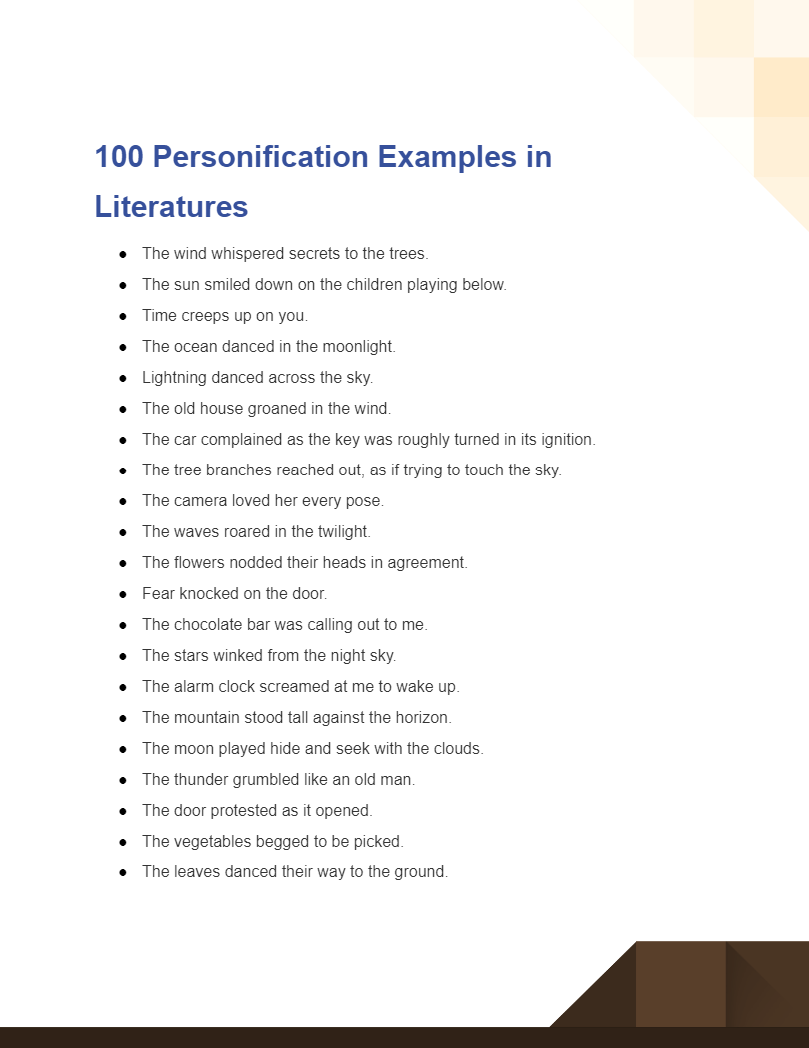
“Daffodils” by William Wordsworth
- “The waves beside them danced” – The waves are given the human action of dancing.
- “Fluttering and dancing in the breeze” – The daffodils are personified as fluttering and dancing.
- “Tossing their heads in sprightly dance” – The daffodils are described as tossing their heads, a human action, in dance.
“The Fog” by Carl Sandburg
- “The fog comes on little cat feet” – The fog is given the characteristic of a cat, moving quietly and softly.
- “It sits looking over harbor and city” – The fog is personified as sitting and looking, like a person would.
- “Then moves on” – The fog is given the human action of moving on.
“Ode to the West Wind” by Percy Bysshe Shelley
- “Thou breath of Autumn’s being” – The West Wind is personified as the breath of autumn.
- “Thou, from whose unseen presence the leaves dead are driven” – The wind is described as having a presence that drives dead leaves.
- “If Winter comes, can Spring be far behind?” – Winter and Spring are personified as entities in a cycle of time.
Personification Literary Device Examples
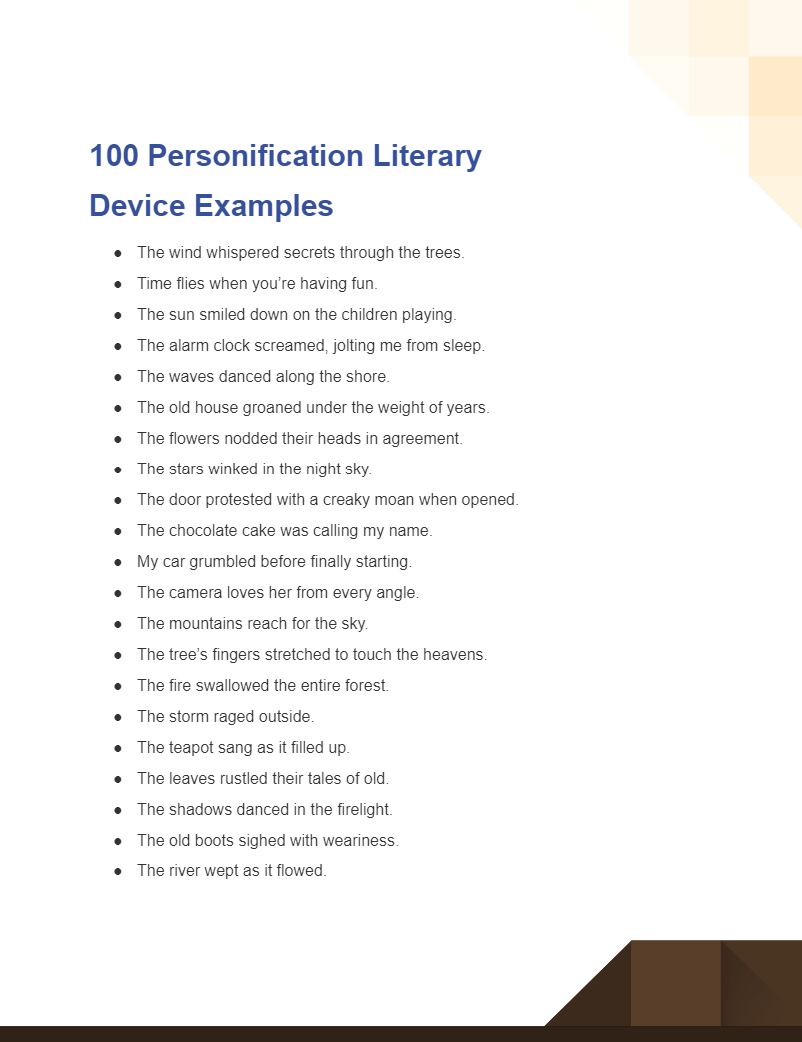
As a revered tool in the literary toolbox, personification enriches narratives, making them lively. These personification literary device examples illustrate its classic utilization, adding depth and relatability to tales.
- The breeze whispered secrets to the trees.
- The curtain danced in the summer wind.
- The fire’s fingers licked the dry wood.
- The sun draped the world in a golden blanket.
- The piano sang a melody of days long past.
Easy Personification Examples
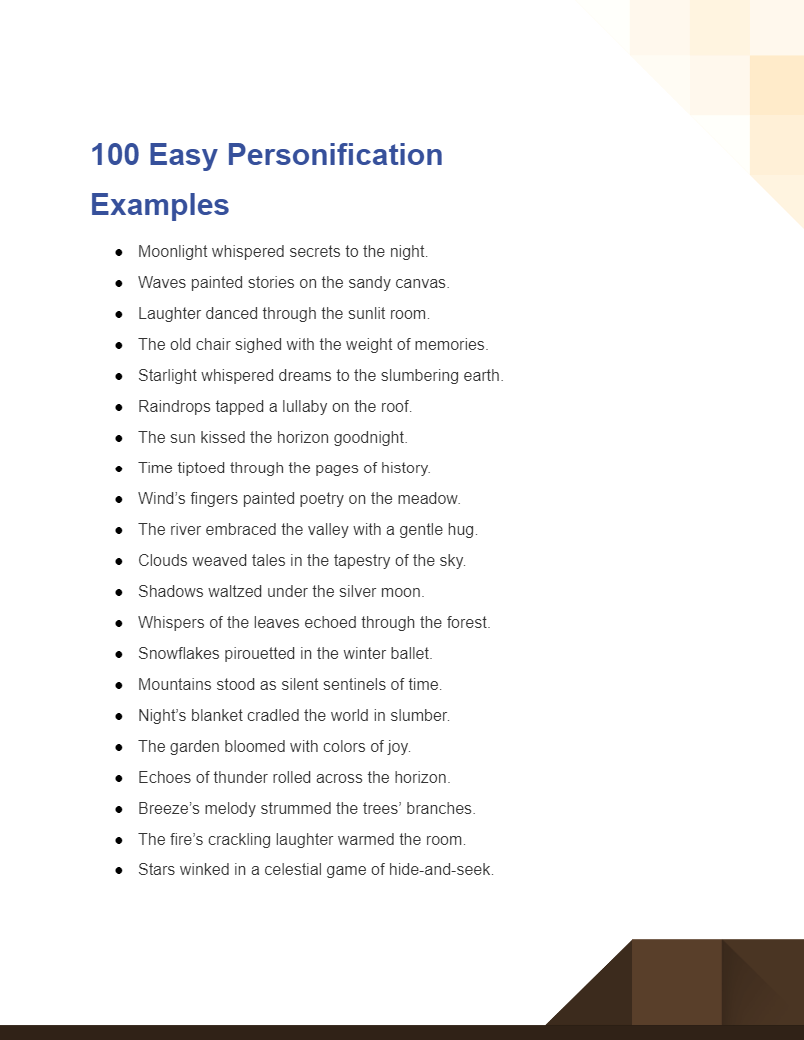
For those new to the concept or seeking straightforward instances, these easy personification examples illuminate the technique in its simplest, most direct form.
- The clock is running fast today.
- The flowers are dancing in the wind.
- The car is coughing and won’t start.
- The sun is smiling down at us.
- The kettle is singing.
Hard Personification Examples

For those seeking a deeper understanding or more intricate instances, these hard personification examples showcase a nuanced application of the literary device, demanding closer attention and reflection.
- The secrets of the forest whispered tales of ancient epochs.
- Time, the relentless thief, steals our moments.
- The city’s heartbeat pulses through its bustling streets.
- The history, woven into the tapestry of the old manor, speaks volumes.
- The shadows of the past loom over the present.
Personification Examples about a Girl
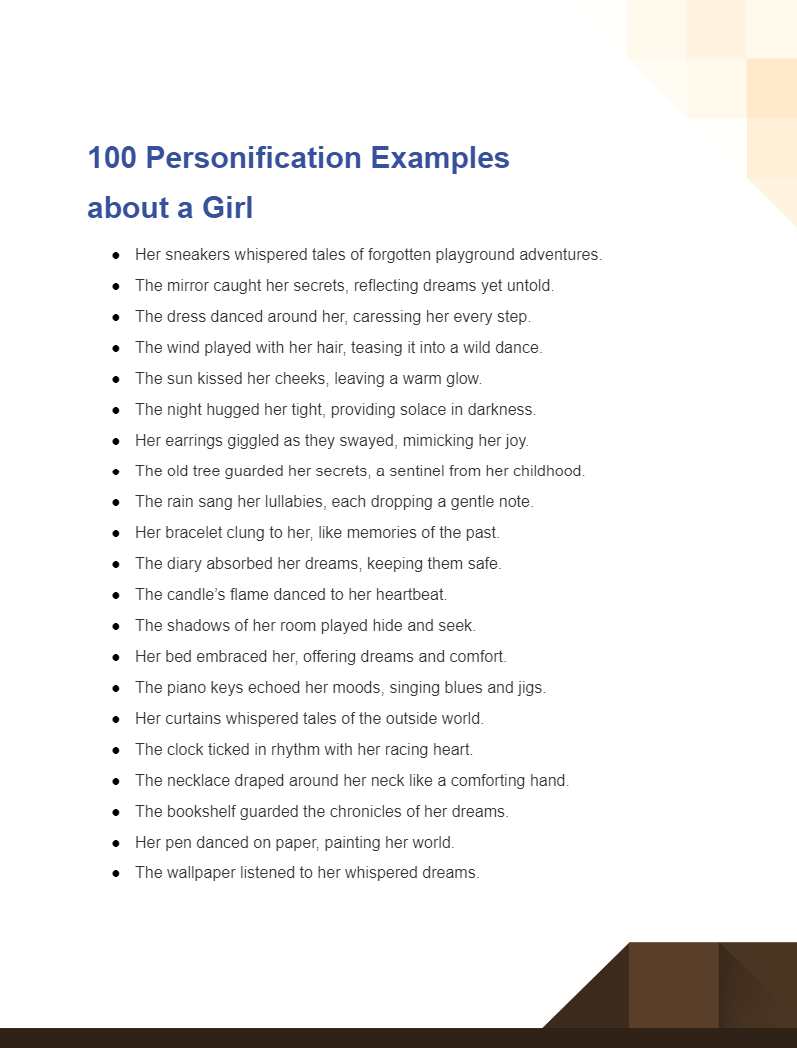
Drawing upon the myriad emotions, phases, and experiences of girlhood, these personification about a girl examples encapsulate the world as seen, felt, and lived by a girl.
- Her diary held the secrets of her blooming heart.
- The dresses in her closet whispered tales of parties and picnics.
- Her dreams, vibrant and wild, soared on wings of fantasy.
- The mirror reflected not just a face, but a tapestry of hopes.
- The shoes remembered every journey, from faltering steps to confident strides.
Personification Examples about a Boy
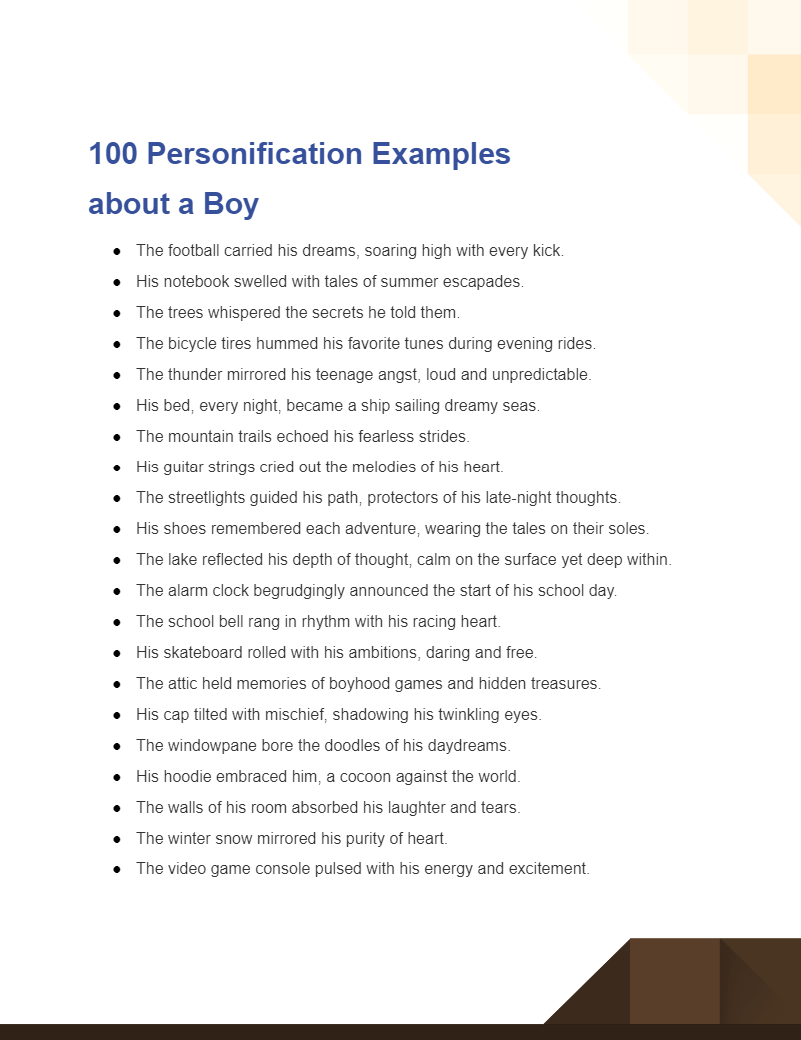
Venturing into the world of boyhood with its adventures, dreams, and challenges, these personification about a boy examples paint vivid portraits that resonate with the journey of growing up as a boy.
- The football bore the sweat and aspirations of his ambitions.
- His bicycle, his first taste of freedom, carried tales of neighborhoods explored.
- The walls of his room witnessed dreams being built.
- The old oak tree remembered his initials carved with youthful exuberance.
- The pond mirrored his evolving reflections.
Personification Examples in Movies
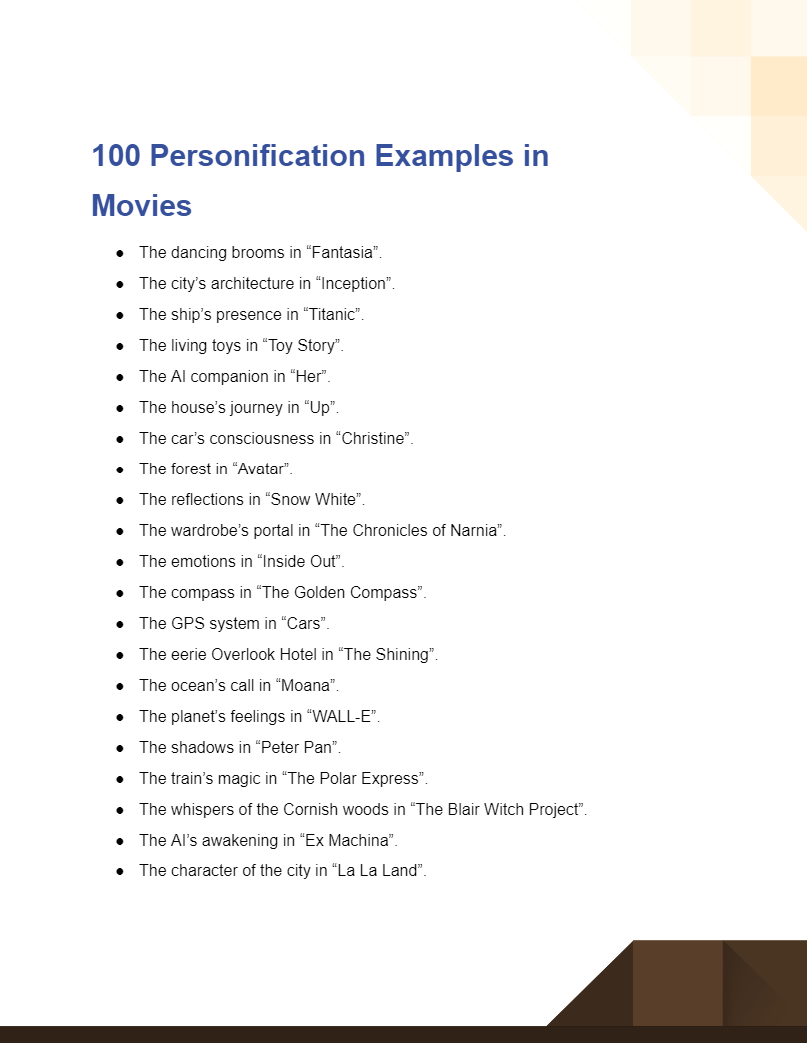
Personification examples in Movies utilize various literary techniques to deepen the narrative, and personification is no exception. By attributing human traits to non-human entities, filmmakers amplify emotions and strengthen connections with audiences.
- “The night is darkest just before the dawn.” – The Dark Knight
- “This forest is old, very old. Full of memory… and anger.” – The Lord of the Rings
- “The building has a consciousness.” – The Shining
- “The ocean chose you.” – Moana
- “The wind has changed.” – Mary Poppins
Personification Examples in TV Shows
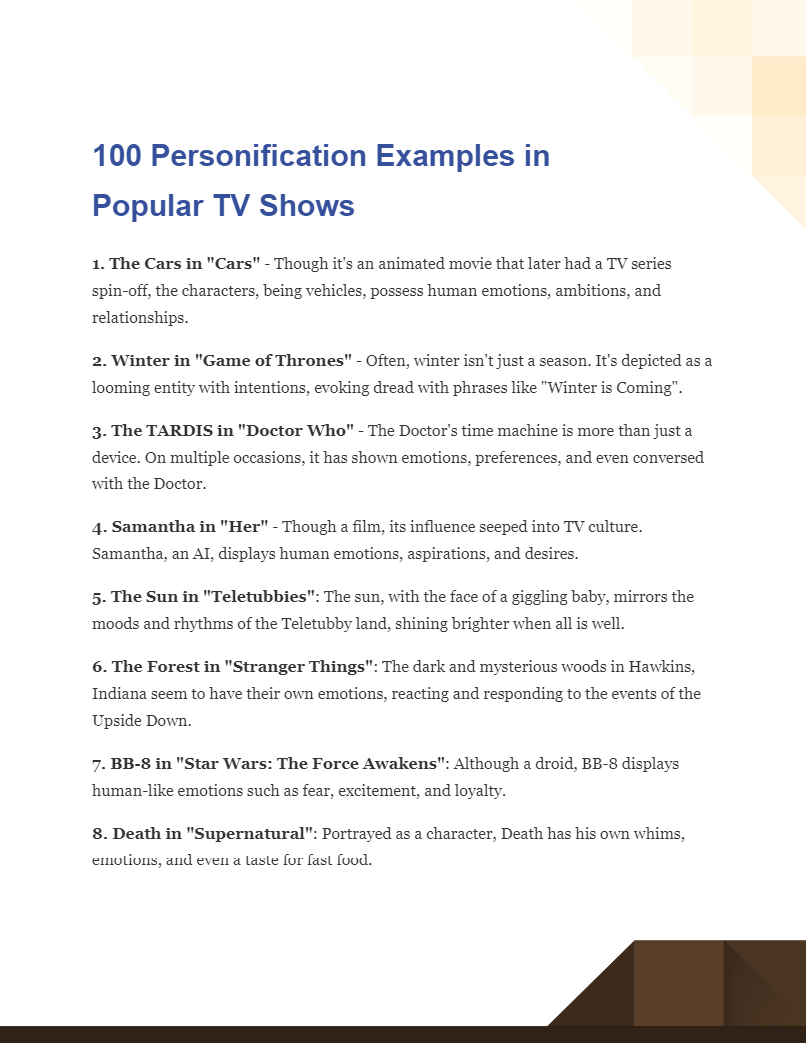
Personification in TV shows, spanning various genres and themes, often resort to personification to emphasize and enrich their narratives. Through humanizing the inanimate, these shows create memorable moments and dialogues.
- “The walls of this palace have ears.” – Game of Thrones
- “New York may be the city that never sleeps, but it sure does dream.” – Sex and the City
- “The darkness is a patient thing.” – Stranger Things
- “The Island isn’t done with you yet.” – Lost
- “This town has secrets.” – Twin Peaks
Personification Figurative Speech Examples
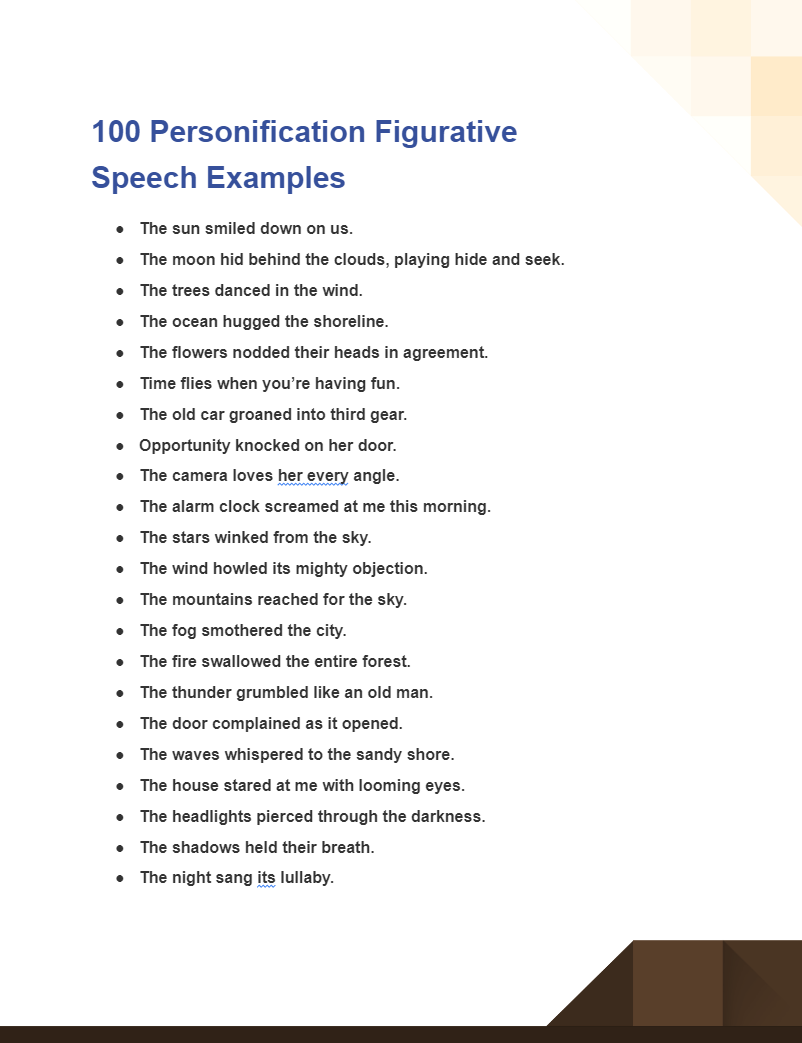
Personification in figurative speech thrives on literary devices, and personification is a stellar member of this group. It transforms abstract ideas and inanimate objects, making them relatable and vivid.
- “The alarm clock screamed at me this morning.”
- “Jealousy is the green-eyed monster.”
- “The flood raged over the entire village.”
- “Luck has a funny way of coming into people’s lives.”
- “Karma has a ledger.
Personification Examples for Class 10
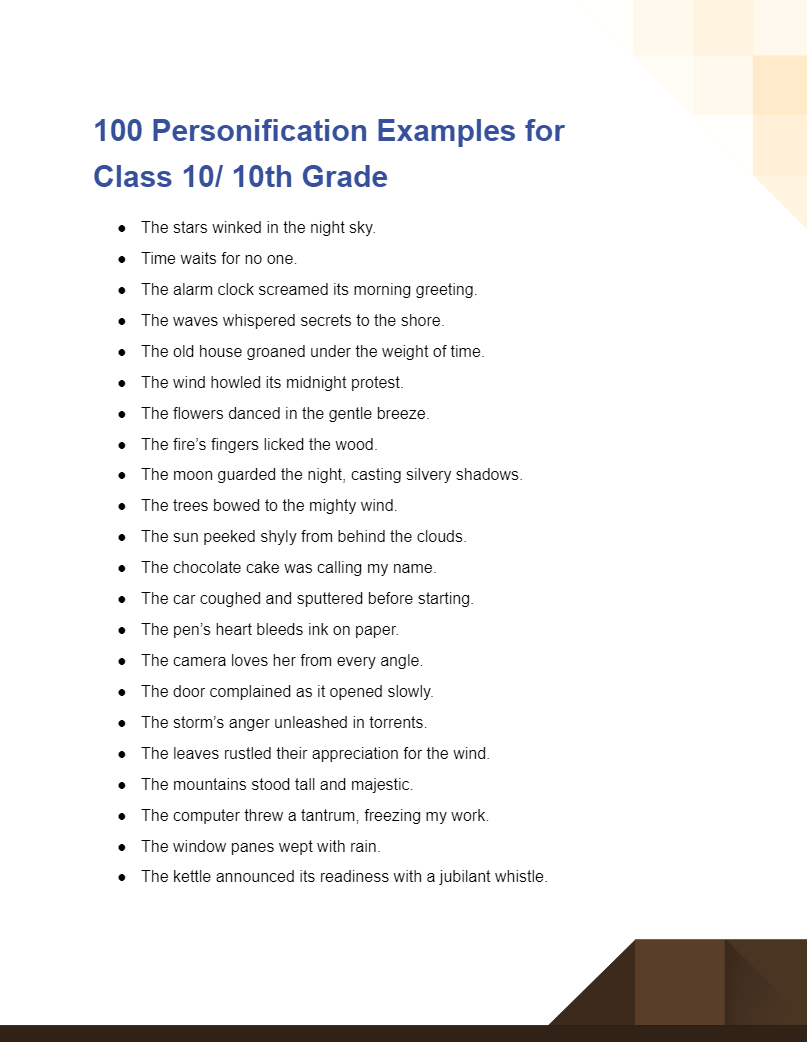
Class 10 heralds a refined understanding of literary nuances. Personification examples of class 10 at this level meld emotion and imagery, stimulating creative minds further.
- The breeze whispered secrets only the trees could understand.
- The ancient vase held tales of forgotten civilizations.
- The cathedral stood majestic, a silent sentinel of faith.
- The desert sung lullabies of loneliness and heat.
- The typewriter reminisced of stories once told.
Personification Examples for Middle School
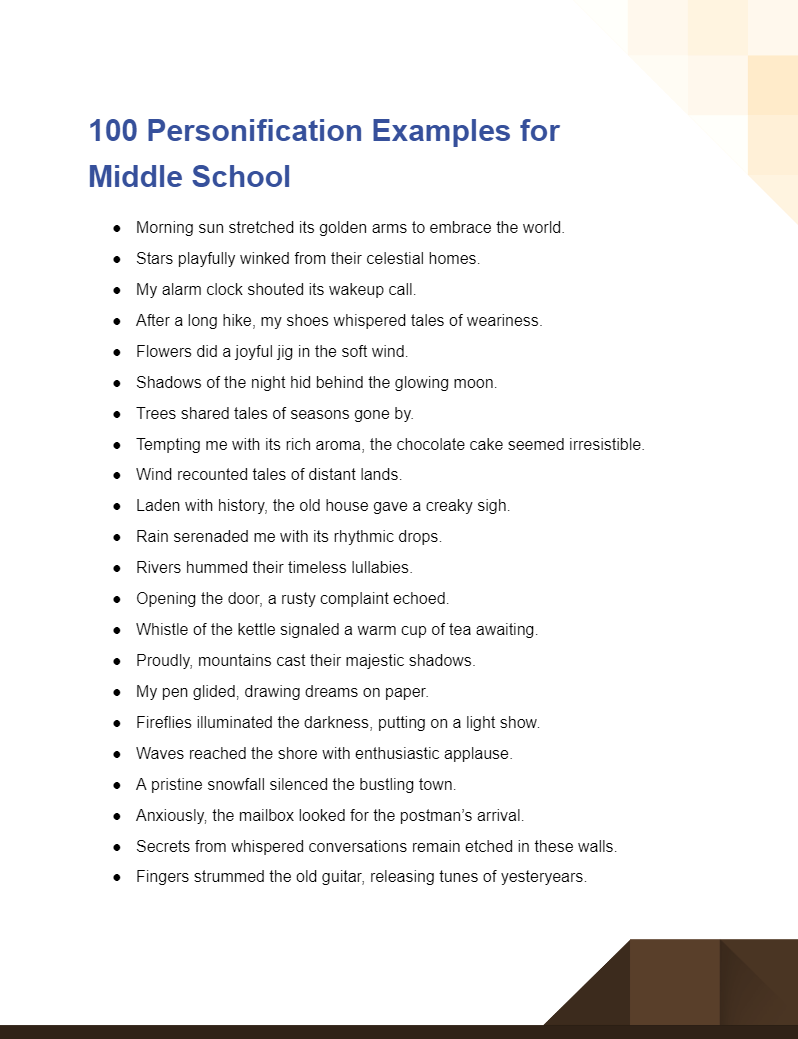
Middle school personification literature serves as a bridge between basic and advanced literary understanding. Personification at this juncture invites students to envision deeper emotional connections.
- The autumn leaves danced to the ground.
- The old train’s whistle screamed in the distance.
- The daisy smiled up at the sun.
- The thunder grumbled like an old man.
- The ancient tree groaned in the wind.
Personification Examples for High School
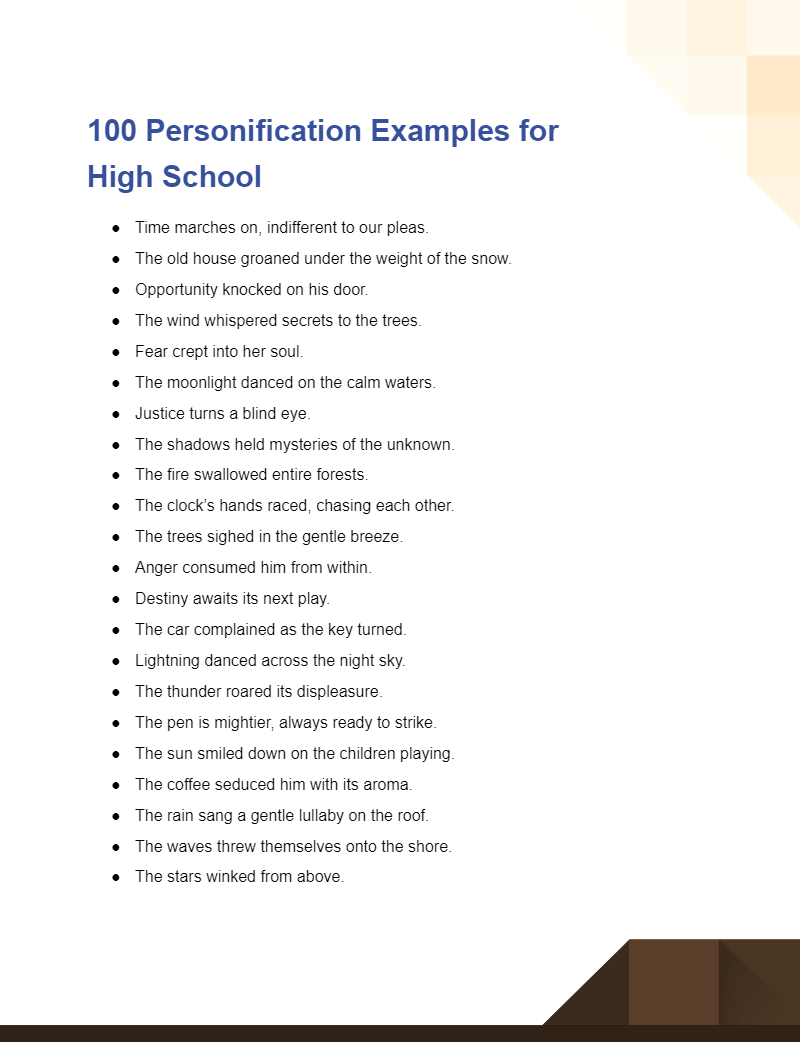
As high school literature dives deeper into human experiences and emotions, personification of high school becomes even more refined. These examples aim to stir profound reflection.
- The boulevard echoed with stories of countless souls.
- The lighthouse guided the lost with its unwavering light.
- The ancient tome held wisdom of millennia.
- The metropolis buzzed with dreams and ambitions.
- The glacier carved stories on mountain faces.
Personification Examples for College

College literature transcends conventional boundaries, exploring vast terrains of human experience. These personification examples for college are tailored for mature minds seeking profound interpretations.
- The novel held lifetimes within its pages.
- The violin wept melodies of a time long past.
- The city skyline bore testament to dreams built brick by brick.
- The ancient ruins whispered sagas of glory and decay.
- The tapestry narrated histories woven thread by thread.
Personification Examples for Stars
Stars, those distant luminous bodies, have long been personified in literature, symbolizing hope, dreams, or destiny. Through personification, stars gain qualities allowing them to interact and evoke emotions like human characters.
- The stars whispered secrets of the ancient universe to the curious night sky.
- Last night, the stars chuckled softly, sharing a celestial joke.
- Each star bowed gracefully as the moon took center stage.
- The stars held a vigilant watch over the sleeping world.
- Shyly, a star hid behind a wispy cloud, playing peek-a-boo.
Personification Examples in Figure of Speech
Personification, as a figure of speech, endows non-human subjects with human qualities. This embellishment breathes life into descriptions, painting vivid mental images and forging emotional connections.
- “The old clock on the wall coughed and groaned, announcing each hour.”
- “My alarm clock screams at me every morning, demanding I wake up.”
- “The little stream danced and frolicked over pebbles, singing its merry tune.”
- “The window panes held back their tears during the storm.”
- “The fire crackled, narrating tales of olden days to the entranced listeners.”
Personification Examples for Sparrow
Sparrows, with their tiny stature and cheerful chirrups, have often been subjects of literary personification. Through this, these birds are painted with a richer palette of emotions and actions.
- The sparrow sang a joyful tune, announcing the dawn.
- The sparrow proudly showed off its nest, a testament to its hard work.
- The young sparrow hesitated, taking its first uncertain flight.
- The sparrow whispered sweet melodies to the blooming flowers.
- In the rain, the sparrow shielded its young with tender wings.
Personification Starter Examples
Beginning a sentence with personification can immediately draw readers into the scene, establishing an emotional tone. These starters give inanimate objects or animals human-like attributes, setting the stage for a compelling narrative.
- The old bookshelf groaned under its weight, begging for relief.
- The breeze whispered secrets, rustling the autumn leaves.
- The lonely mailbox waited, hoping for a letter.
- The silver moon yawned, signaling the end of its nocturnal watch.
- The diligent pen raced across the page, eager to tell its story.
Personification Examples about Love
Love, an emotion so profound and vast, is sometimes personified to make its impact tangible. By giving love human characteristics, we can explore its depth, whims, and mysteries more intimately.
- Love knocked gently at the door of her heart.
- Love sighed, watching two distant hearts reunite.
- Love patiently waited, knowing that true hearts always find their way.
- Love whispered reassurances during the long, cold nights.
- Love tiptoed, leaving footprints in the sands of time.
Personification Examples for Halloween
Halloween, a time of spooks and tales, brings with it a whirlwind of emotions and imagery. By personifying aspects of this holiday, we can add depth and character to the otherwise inanimate elements of this festivity.
- The haunted house moaned, protesting against the winds of October.
- Halloween whispered secrets of old witches and timeless ghosts.
- Old costumes sighed, reminiscing Halloweens of yesteryears.
- Haunted tales rose from the pages, eager to be told.
- Halloween’s shadows danced, celebrating the realm of the supernatural.
Personification Examples for Winter
Winter, with its cold embrace and silent nights, is more than just a season. By personifying winter, we capture its beauty, melancholy, and the intimate moments it brings.
- Winter whispered through the bare trees.
- Ice patches grinned, waiting to trip the unwary.
- Frost painted delicate patterns on window panes.
- Winter wrapped the world in a serene white blanket.
- The cold air sighed, leaving breath visible.
Personification Examples on Nature
Nature, in all its splendor and fury, holds myriad emotions. Through personification, nature’s elements are given voice, allowing us to connect with them deeply.
- The mountains stood tall, witnessing millennia.
- Trees chatted, rustling their leaves in the wind.
- The desert sighed, yearning for a drop of rain.
- Oceans roared, echoing the depth of their mysteries.
- The forest listened, a keeper of age-old secrets.
Personification Examples on Rain
Rain, nature’s way of nurturing and cleansing, carries emotions ranging from joy to melancholy. By personifying rain, we dive into its rhythmic tales and refreshing narratives.
- The raindrops whispered tales of distant oceans.
- Rain serenaded the night, lulling it to sleep.
- Raindrops danced on rooftops, creating nature’s own rhythm.
- The storm sent torrents, declaring its presence.
- The rain curtain unveiled a fresh, washed world.
Personification Examples on Wind
Wind, the unseen traveler, carries with it stories from far and wide. Through personification, we give voice to the wind’s journey, its whispers, and its mighty roars.
- The wind sang lullabies through the trees.
- Gusty winds boasted of their wild adventures.
- The gentle breeze caressed my face with a cool touch.
- Whistling winds told tales of distant lands.
- Leaves rustled, dancing to the wind’s tune.
Personification Examples in Poems
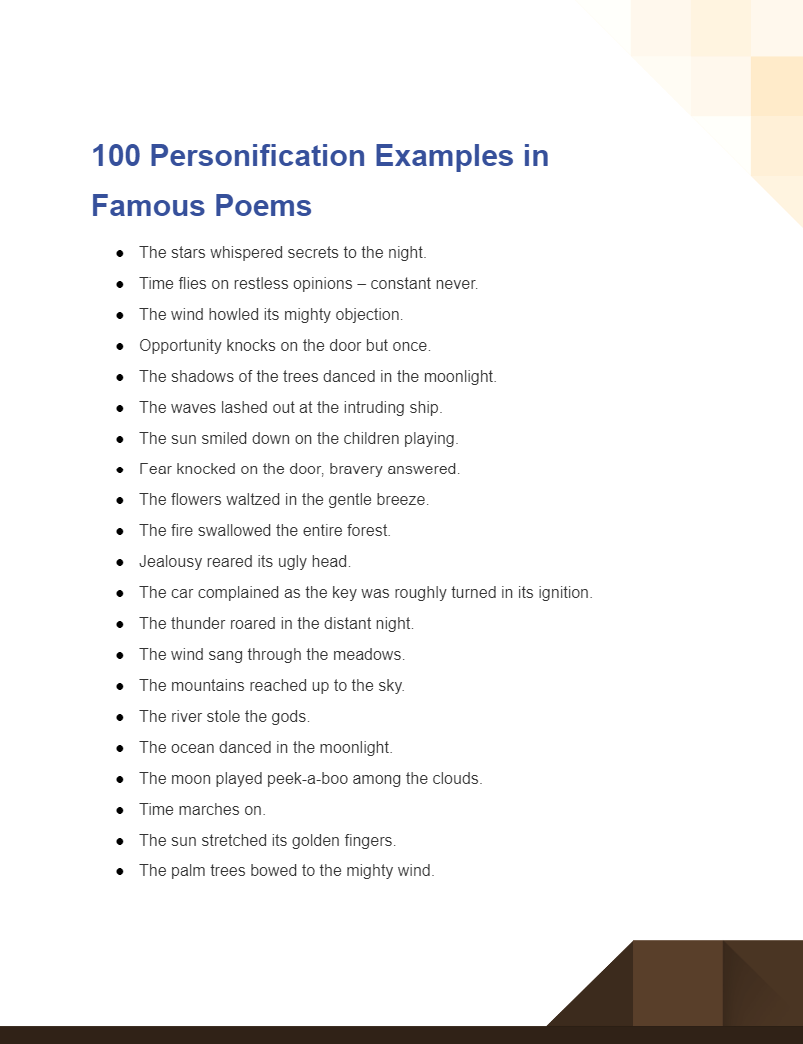
Personification in Poetry, a realm where emotions are given wings, often employs personification to create vivid imagery and evoke deeper emotions. Delving into these poetic lines, we discover nature and objects imbued with life and sentiment.
Examples:
- “The moon smiled at the weary traveler, guiding his path.”
- “The ancient tree wept, shedding leaves like golden tears.”
- “Rivers sang, their melodies echoing through valleys.”
- “The candle flame danced, casting shadows of a bygone time.”
- “Stars whispered dreams into the night’s ear.”
- “The forest’s heart beat with tales untold.”
- “Desert sands murmured of long-lost civilizations.”
- “The dawn blushed, painting the world in hues of hope.”
- “Waves clapped, celebrating the union of sky and sea.”
- “The twilight sighed, bidding farewell to the day’s last light.”
Personification Examples in Everyday Language
- The leaves whispered secrets to each other as the wind passed through.
- The alarm clock nagged me awake with its incessant ringing.
- The clouds marched across the sky, determined to block out the sun.
- The old car groaned in protest as it climbed the steep hill.
- The fire crackled and roared, hungry for more wood.
Explanation
Personification is a literary device where human traits are attributed to non-human entities. These examples vividly illustrate this technique, helping readers understand how to make their writing more engaging and imaginative.
How to Write a Personification – Step by Step Guide
- Understanding Personification:
- Begin by grasping the concept of personification. It involves attributing human-like characteristics, emotions, or actions to non-human entities or inanimate objects.
- Identify the Subject:
- Decide on the non-human subject or object you want to personify. Whether it’s nature, an object, or an abstract concept, having a clear subject makes the process smoother.
- Determine the Emotion or Action:
- What do you want your subject to express or do? Is the sun smiling down, or are the old walls of a house keeping secrets?
- List Human-like Qualities:
- Think of human actions, emotions, or characteristics that can relate to your chosen subject. For instance, trees might “whisper” or “dance.”
- Craft the Sentence:
- Begin to frame your sentence. Ensure it’s clear that the non-human subject is doing something typically reserved for humans.
- Be Context-Aware:
- Consider the broader context of where your sentence will be placed. If it’s within a story or poem, ensure the personification complements the narrative.
- Review and Refine:
- Read the sentence out loud. Does it sound natural? Is the human-like action or emotion attributed to the subject clear and evocative? If not, tweak until satisfied.
Tips to Write Personification
- Keep it Realistic: Ensure the personification is plausible and not overly exaggerated.
- Use in Moderation: Limit the use of personification to avoid overcrowding your writing.
- Consistency is Key: Stick to the same characteristics for an entity throughout your piece.
- Match Emotion with Mood: Align the emotions in your personification with the overall tone of your writing.
- Get Feedback: Have someone review your personifications to see how they resonate with others.
- Explore a Range of Emotions: Be creative in attributing different emotions to inanimate objects.
- Avoid Overdoing It: Refrain from personifying multiple elements in the same section.
- Practice and Read: Regularly write personification sentences and read works that use them effectively.


